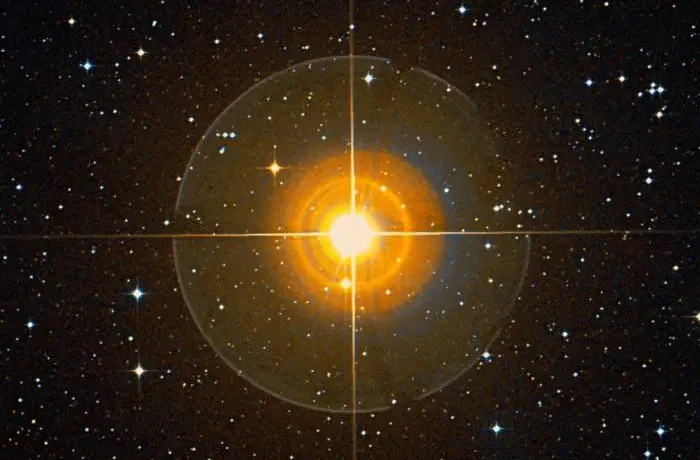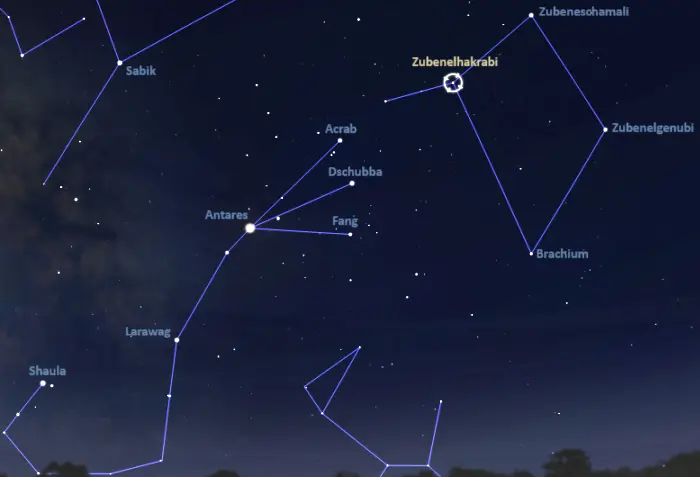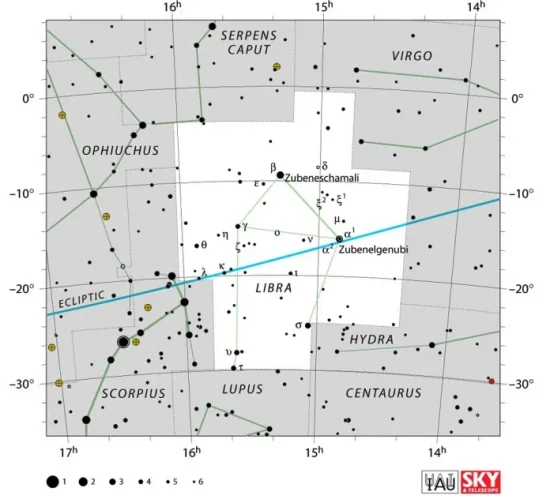Zubenelhakrabi, Gamma Librae (γ Lib), is the primary component in a double or multiple star system located approximately 163 light-years away in the constellation Libra. With an apparent magnitude of 3.91, it is the sixth brightest star in Libra. It hosts two exoplanets, Gamma Librae b and c, discovered in 2018.
Star system
Gamma Librae is a binary or multiple star system with the stellar classification G8.5 III. The primary component, Gamma Librae A, is an evolved yellow giant star with a mass of 1.15 solar masses and a radius 11.14 times that of the Sun. With an effective temperature of 4,826 K, it is 72 times more luminous than the Sun.
Zubenelhakrabi is a relatively slow spinner, with a projected rotational velocity of 1.60 km/s. The giant star is slightly younger than the Sun. It has an estimated age of 4.31 billion years.
In 1940, Zubenelhakrabi was separated by 0.10 arcseconds from its companion. A visual companion lies at a separation of 42.5 seconds of arc. It has an apparent visual magnitude of 11.2.

Zubenelhakrabi (Gamma Librae), image: Wikisky (DSS2)
Planets
Zubenelhakrabi hosts two gas giant planets, designated Gamma Librae b and Gamma Librae c. The discovery of the planets was announced on April 11, 2018. Both planets were detected using the radial velocity method. They were discovered by a team of astronomers led by Takuya Takarada at the Tokyo Institute of Technology in Japan.
Gamma Librae b orbits the parent star with a period of 415.2 days, with a semimajor axis of 1.24 astronomical units (AU). Other sources give a period of 414.9 days, a mass of 1.126 Jupiter masses, and an orbital radius of 1.319 AU.
Gamma Librae c takes 964.6 ± 3.1 days (2.6 years) to complete an orbit, with a semimajor axis of 2.17 AU. Other sources give a separation of 2.318 AU from Zubenelhakrabi. The planet has 5.231 times the mass of Jupiter.
Facts
Zubenelhakrabi is the sixth brightest star in Libra, after Zubeneschamali (Beta Librae), Zubenelgenubi (Alpha2 Librae), Brachium (Sigma Librae), Upsilon Librae, and Tau Librae.
Like many other stars in zodiac constellations, Zubenelhakrabi appears near the ecliptic (the Earth’s orbital plane around the Sun, or the Sun’s apparent path across the sky) and can be occulted by the Moon. The lunar occultations allow astronomers to measure the star’s angular size. In July 1979, they found an angular diameter of 2.16 and 2.15.
Name
The name Zubenelhakrabi (pronunciation: /zuːˌbɛnɛlˈhækrəbi/) comes from the Arabic phrase Zubān al-ʿAqrab, meaning “the claws of the scorpion.” Like the names of the brighter Zubeneschamali (Beta Librae, “the northern claw”) and Zubenelgenubi (Alpha2 Librae, “the southern claw”), the name Zubenelhakrabi comes from a time when the constellation Libra was part of Scorpius and seen as representing the Scorpion’s claws.
The name was historically also spelled Zuben-el-Akrab, Zuben Hakraki, Zuben el Hakrabi, and Zuben Elekrab.
The name Zubenelhakrabi was approved by the International Astronomical Union’s (IAU) Working Group on Star Names (WGSN) on September 5, 2017. It formally applies only to the primary component in the Gamma Librae system but has traditionally been used for the whole star system.
In traditional Chinese astronomy, Gamma Librae was known as 氐宿三 (Dī Xiù sān), the Third Star of Root. Root was an asterism formed by Zubenelhakrabi with Zubenelgenubi (Alpha2 Librae), Iota1 Librae, and Zubeneschamali (Beta Librae). The asterism was part of the larger Root mansion, which represented the chest of the Azure Dragon.
Location
Zubenelhakrabi is easy to find because it appears next to the bright stars that form the Scorpion’s claws. It lies roughly halfway between Acrab, the northernmost bright star of the claws, and Zubeneschamali, the brightest star in Libra.
Zubeneschamali can be found by following the imaginary line extended from Antares at the heart of Scorpius through Acrab. It is one of the several relatively bright stars that appear as the extended claws of the celestial Scorpion.
At declination -14° 47’, Zubenelhakrabi is easily visible from both hemispheres. The best time to observe it from the northern hemisphere is during the late spring and early summer.

The location of Zubenelhakrabi (Gamma Librae) in the sky, image: Stellarium
Constellation
Zubenelhakrabi is located in the constellation of Libra. Like other constellations of the zodiac family, Libra is one of the Greek constellations, catalogued by the Greco-Roman astronomer Claudius Ptolemy of Alexandria in his Almagest in the 2nd century CE. It occupies an area of 538 square degrees of the southern sky near the celestial equator and is the 29th constellation in size.
Libra has been associated with the weighing scales since ancient times. Ancient Babylonians knew it as MUL Zibanu, meaning “scales” or “balance.” In ancient Greece, the constellation was seen as part of Scorpius. The Romans associated it with the scales held by Astraea, the goddess of justice and equivalent to the Greek Dike. Dike is linked with the neighbouring constellation Virgo.
Libra is not particularly bright. Only its two brightest stars – Zubeneschamali (Beta Librae) and Zubenelgenubi (Alpha Librae) – are brighter than magnitude 3.0. The constellation hosts 83 visible stars, and its constellation figure is easily made out next to the brighter Scorpion from areas without too much light pollution.

Libra constellation map by IAU and Sky&Telescope magazine
Zubeneschamali, Libra’s brightest star, shines at magnitude 2.61 from a distance of 185 light-years. It is a hot B-type main sequence star with a luminosity of 130 Suns.
Other notable stars in Libra include the multiple star systems Alpha Librae (Zubenelgenubi) and Iota1 Librae, the binary stars Sigma Librae (Brachium) and Tau Librae, the K-type giant Upsilon Librae, the yellow giant Theta Librae, the red dwarf Gliese 581 and the yellow dwarf 23 Librae, the last two of which host three and two extrasolar planets respectively.
Libra also contains two exceptionally old stars. The red giant HE 1523-0901 is one of the oldest stars known, with an estimated age of 13.2 billion years. The subgiant HD 140283, popularly known as the Methuselah Star, is around 12 billion years old.
Libra does not host any exceptionally bright deep sky objects. It is home to the globular cluster NGC 5897, the interacting spiral galaxy NGC 5917, the active spiral galaxy NGC 5793, and the barred spiral galaxies NGC 5728, NGC 5885, and NGC 5792.
The best time of the year to see the stars and deep sky objects in Libra is during the month of June, when the constellation appears higher above the horizon in the early evening. The entire constellation is visible from locations between the latitudes 65° N and -90° S.
The 10 brightest stars in Libra are Zubeneschamali (Beta Lib, mag. 2.61), Zubenelgenubi (Alpha Lib, mag. 2.741), Brachium (Sigma Lib, mag. 3.29), Upsilon Librae (mag. 3.628), Tau Librae (mag. 3.68), Zubenelhakrabi (Gamma Lib, mag. 3.91), Theta Librae (mag. 4.136), 16 Librae (mag. 4.49), Iota1 Librae (mag. 4.54), and 37 Librae (mag. 4.61).
Zubenelhakrabi – Gamma Librae
| Spectral class | G8.5 III |
| Apparent magnitude | +3.91 |
| Absolute magnitude | −1.59 |
| Distance | 163 ± 2 light-years (50.0 ± 0.5 parsecs) |
| Parallax | 19.99 ± 0.16 mas |
| Radial velocity | −26.71 ± 0.04 km/s |
| Proper motion | RA: +65.34 ± 0.19 mas/yr |
| Dec.: +7.45 ± 0.15 mas/yr | |
| Mass (γ Lib A) | 1.15 M☉ |
| Luminosity (γ Lib A) | 72 L☉ |
| Radius (γ Lib A) | 11.14 R☉ |
| Temperature (γ Lib A) | 4,826 ± 48 K |
| Metallicity (γ Lib A) | −0.26 ± 0.03 dex |
| Age (γ Lib A) | 4.31 billion years |
| Rotational velocity (γ Lib A) | 1.60 km/s |
| Surface gravity (γ Lib A) | 2.81 ± 0.18 cgs |
| Constellation | Libra |
| Right ascension | 15h 35m 31.5788082s |
| Declination | −14° 47′ 22.327851″ |
| Names and designations | Zubenelhakrabi, Gamma Librae, γ Librae, γ Lib, 38 Librae, HD 138905, HR 5787, HIP 76333, SAO 159370, FK5 577, GJ 3912, BD−14° 4237, GC 20949, GCRV 8992, PPM 230451, PLX 3516, JP11 2619, TIC 386935627, IRAS 15327-1437, 2MASS J15353157-1447222, IRC -10323, SACS 340, WEB 12958, UBV 13327, UBV M 20842, TYC 5608-1381-1, Gaia DR2 6265374394490149248, WRH 20, CCDM J15355-1447AP, ADS 9704 AP, WDS J15355-1447A, WDS J15355-1447Aa,Ab |